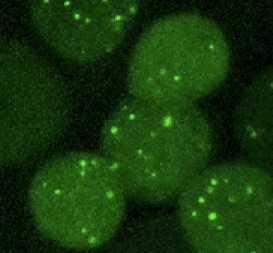Research









Macroautophagy is a degradative process of cellular components that has been conserved in eukaryotic evolution. In certain circumstances, like starvation or cellular stress, parts of the cytoplasm are included in double membrane vesicles called autophagosomes that fuse later to lysosomes where they are degraded. Autophagy is also induced in other circumstances like the elimination of protein aggregations, organelles or bacteria and it is therefore of immense importance in diverse pathological processes as well as in aging. We have identified Vmp1 as a new protein involved in autophagy and its role in the origin of autophagosomes.
We use an integrated approach that combines biochemistry, genetics and cell biology in the experimental model Dictyostelium discoideum and mammalian cells to identify and characterize new conserved proteins of unknown function involved in autophagy.
Autophagosomes at different degree of maturation in a Dictyostelium cell
Autophagy, the cell´s broom

Detection of autophagosomes in Dictyostelium and and human HELA cells


The autophagic machinery. The ongoing proteome studies allow the identification of new autophagic proteins


Lines of Research:
Identification of new proteins of the autophagic machinery and its regulation
Function of Vmp1 in the origin of autophagosomes and regulation of PtdIns3P signalling
Study of the function of VPS13 protein family. The possible role of autophagy in the associated diseases: Chorea-acanthocytosis and Cohen Syndrome
WIPI proteins in autophagy and its role in the rare disease BPAN